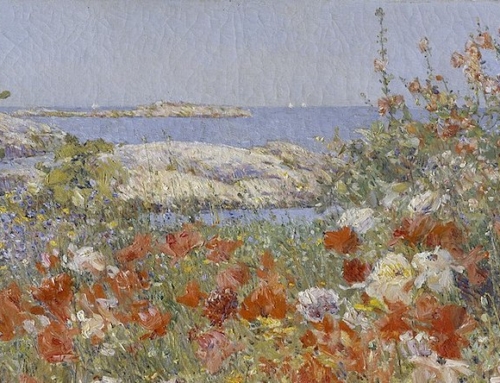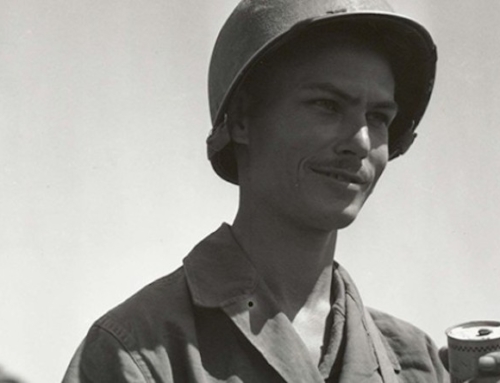“The priest can’t hide; we can see him coming, which becomes important visually… It must be like a Samurai warrior putting their armour on every day to go out to battle the forces of darkness, so that’s what it became, I guess.” -John Michael McDonagh
Considering that the modern, mainstream culture is so often at odds with the Catholic Church, her teachings, and her priests, it is noteworthy that every few years there is a fascination with this ancient fraternity of celibate holy men. The Catholic priest has been portrayed by countless secular authors and filmmakers in the modern world, the most recent portrayal being of Fr. James Lavelle in the movie Calvary (2014). Many of these fictional accounts seek to highlight the holiness of a particular priest; many others seek to expose his sinfulness. The most memorable ones, however, depict the priest as he is, as a man, complex as any other man, yet charged with a unique function: shepherding a people and bringing God to them and them to God. Let us now take a look at the priesthood as it is depicted in this movie, written and directed by John Michael McDonagh, and its admitted predecessor, The Diary of a Country Priest by Georges Bernanos; we will consider as well The Power and the Glory by Graham Greene. (Beware: there are spoilers for all three works below.)
Good Priest vs. Bad Priest
Good
Calvary opens with a startling and graphic confession of an unseen man who details his horrible abuse at the hands of a priest when he was a small child. Immediately we are confronted with the image of the bad priest. But the “penitent” tells Fr. James, who is hearing the confession, that he—Fr. James—is a good priest. The headlines from the past twelve years and more can give us plenty of fodder for reflection and revulsion about bad priests. The good priest does not often make headlines, however, so the viewer is drawn into the main question of the film: what makes a good priest good? To help sort it out, I will identify three qualities that make up the good priests in these three works.
Sacramental
The good priest is sacramental. Once again, this is how Calvary opens to the viewer. The good priest, Fr. James, is hearing confessions. Next, he is shown celebrating Mass and distributing Communion to his flock. Similarly, for Greene’s whiskey priest, distributing the sacraments amidst persecution is just about his only redeeming quality. The Curé in The Diary accomplishes his main victory when he convinces one of his parishioners to end a longtime grudge against her husband, finally bringing her to forgive and be forgiven.
None of the priests seen here view the sacraments as mere symbols, but, rather, as effective moments of grace, moments of salvation. Fr. James dies protecting the spirit and letter of the sacramental seal. The whiskey priest dies because he refuses to run away or apostatize, instead going around the countryside performing his sacred office for the people of God. The Curé dies not performing but receiving the sacraments from his friend, a laicized priest.
This brings us to an important aspect of priestly identity: the ancient doctrine of in persona Christi. This states that because Jesus Christ is the one true priest, all other priests of the Church participate in his priesthood and act sacramentally in his person. The priest, then, is effective ex opere operato in carrying out the sacraments, regardless of his personal sanctity. Thus one can be a bad man and yet a “good” priest because confecting the sacraments does not depend on his worthiness.
Pastoral
The priest is pastor, shepherd of a flock. Fr. James in Calvary inserts himself into the lives of his parishioners; he tries to interrupt the ordinary with the extraordinary. God does not respect our malaise. He knows we need a concrete reminder of his presence. Thus, God became flesh and entrusts his ministry on earth to fleshly representatives. It is harder to shut out a living, breathing man than a gentle voice in the heart.
The Curé also insists on encountering his parishioners on his terms. His great triumph was bringing Mme La Comtesse to forgive her philandering husband. As a pastor and the one who had care of her soul, he knew she had to confront this particular demon deep in her heart even though she wanted anything except for it to be exposed. The good shepherd knows his sheep, and sometimes has to be active in corralling the stray.
Sacrificial
The direct consequence of being pastoral, of inserting God into the lives of others, is the need to be sacrificed. What do our hero-priests have in common? They die. What do they have in common with Christ, in whose person they act? They die. In this they join the ranks of priests gone before them who would rather be killed than cease performing their sacred duty: Becket, Nepomucene, and Fisher, to name just a few. It is not sanctimony. It is gritty, humiliating, and lonely. Why does God appear to forsake them? We see an answer in Calvary.
When Fr. Leary, the bad associate, leaves the priesthood, he is confronted by Fr. James, who the previous night had given him a drunken verbal assault.
Fr. Leary: I didn’t realize you hated me that much.
Fr. James: I don’t hate you at all.
Fr. Leary: Then, why?
Fr. James: It’s just you have no integrity! That’s the worst I can say about anybody.
Indeed integrity, as will be seen below, is Fr. James’s greatest gift, and one he exemplifies without counting the cost. He will not defend himself by exposing his attacker because of the spirit of the sacramental seal and his desire to convert his attacker. He will not kowtow to a rich donor because he is rich. And even though he almost fails, he will not run away when the moment of his death arrives. He is not suicidal as some critics have opined. He allows himself to be offered as a victim like the Son of God, so that, through him, others might have life, such as his daughter, who learns forgiveness through his selfless integrity.
Bad
In Calvary, The Diary of a Country Priest, and The Power and the Glory, the heroic priests are depicted alongside of what we might call “bad priests.” What do we see in them that reveals their failure to live up to the sublime calling of the priesthood? Again, I think we can separate it into three categories.
Practical
Good priests are called to be practical, of course, but the bad priests are practical to the point of casting off their other-worldly identity. As we have seen in Calvary, the associate Fr. Leary ends up leaving at the end, conflicted by doubts he has in the faith. But earlier in the film, there is an amusing but disappointing scene wherein Fr. James and Fr. Leary are interviewing a businessman who is trying to make a donation to the parish, seemingly to humiliate the Church. Many jokes are made throughout the film about how the Church would do anything for money. Fr. James sees this empty offering for what it is and challenges the tempter; Fr. Leary takes the bait and is blinded by the monetary temptation. Fr. James’s motivation is the salvation of souls in his care, and everything else stands in relation to that, leading him even to the point of trying to convert his assassin. As the Curé in The Diary says: “We pay a heavy, very heavy price for the superhuman dignity of our calling. The ridiculous is always so near to the sublime. And the world, usually so indulgent of foibles, hates ours instinctively.” The priest of today has to show that there is in fact another world, another set of criteria for life, which is not easily apparent, even if this means looking foolish.
Self-centered
The ex-priest M. Dufréty, who ends Bernanos’s novel by hearing the final confession of the country priest, left the priesthood to live with a woman. In a letter written to the Curé, he says, “We were always playing at make believe; we invented our troubles and joys, we invented life instead of living it. A busy healthy life, normal in every way…should contain no mysteries.” What M. Dufréty did not realize in his creed is that the mysteries of life—the mystery of redemption, salvific suffering, the life of unmerited grace—are what remove us from the abyss of meaninglessness in daily life. The mysteries are what transform life to make it worth living. The priesthood exists for others: it is a yoke which is unbearable for man, but that is why a mere mortal cannot bear it. It must be borne by the one true priest, Jesus Christ. Then is the yoke easy and the burden light. The priest must in some way sacrifice “living life for himself,” for the sake of the lives of those in his care.
Cowardly
The worst priest seems to be Padre José in The Power and the Glory. Not only has he left the priesthood, he will not exercise his sacred healing for a dying confrere for fear of the authorities. It is hard to imagine one who reflects Jesus Christ, the great priest-victim, more distantly. As the whiskey priest finds himself on the eve of his execution, he makes his last request: “If you would give me permission to confess.” When the lieutenant approaches the only priest around, Padre José, his brow-beating wife forbids him to go. “It will be all over town…There’ll be no end of it—everybody will be wanting to confess, and the Governor will hear of it, and the pension will be stopped.” Padre José responds, “Perhaps, my dear, it’s my duty…My dear, it’s only that…well…I am a priest.” However, he gives in to his wife, and fails to go. The priest cannot hide, not even this despicable character. And yet, he can try.
In Calvary, Fr. James is always seen wearing his cassock, or soutane, until a climactic moment in the end, where he too tries to hide wearing a simple sweater, trying in vain to escape. However, in the airport, he is approached by a woman whom he counseled, whose faith is strong. The woman, from Italy, lost her husband while traveling in Ireland.
Teresa: Father? You’re going to Dublin?
Fr. James: Yeah. Just getting away for a while, you know?
Teresa: I’m bringing him home. (Referring to her husband’s coffin) To his family in Italy. Dublin and then…Rome.
Fr. James: How have you been?
Teresa: People here have been very kind to me.
I mean…You know, sometimes…I think I cannot go on.
But…I will go on.
This is Fr. James’s “Quo Vadis” moment. Beautiful in its simplicity, Fr. James is trying to hide and escape the cross: the cross of his own weakness of alcoholic rage which reared its ugly head the night before, and the cross of his death. But he cannot hide. He is met by a woman who has lost her husband, but courageously chooses to “go on” through Calvary to the Resurrection. How can he not now? When about to board the plane, he sees the coffin about to be loaded and the baggage workers leaning on it in total irreverence. This seems to be the last straw. Without the intrusion of grace in life, he sees man returning to an animal state.
Analysis
Do these works present a worthy account of the modern Catholic priest? I think that, for the most part, they do. In these artistic works, we see the priest as a paradox. Cardinal Newman in his excellent treatise on the priesthood writes: “[God] has sent forth for the ministry of reconciliation, not Angels, but men; He has sent forth your brethren to you, not beings of some unknown nature and some strange blood, but of your own bone and your own flesh, to preach to you.” God sent living, breathing paradoxes to continue the mission of salvation. The priest is a “real” man, as Fr. Robert Barron of Mundelein Seminary notes in his review of Calvary. He is a mere man who must lead others above the realm of mere men. And this paradoxical person of the priest makes for great literature, just as the paradox of a God-man has transfixed billions for the past two millennia.
G.K. Chesterton, commenting on Job, writes, “We see Job tormented not because he was the worst of men, but because he was the best. It is the lesson of the whole work that man is most comforted by paradoxes.” The stories of good priests in France, Mexico, and Ireland, persecuted by their flock, comfort us. They show that God is not put-off by our rejection. We are not aliens any longer, but because of the Incarnation, we are invited into the divine. We are made beautiful paradoxes as well—in the world but not of it.
And this leads us to a further quality of the good priest: he is relatable. The priest of God has to perform a unique function, but he does it in the trenches. He is at home in the trenches because he himself is a sinner, witnessing to the sanctifying grace that he hopes to impart through his priestly ministry by displaying the effect it has had in his own life.
Of course, the priest’s ministry is not limited to his weakness. His witness to the grace of Christ transforming him makes his priestly ministry that much more effective. “Modern man listens more willingly to witnesses,” said Blessed Paul VI, “than to teachers, and if he does listen to teachers, it is because they are witnesses.” The whiskey priest witnesses to the effectiveness of the sacraments. That is essential. But the priests in Calvary and The Diary of a Country Priest witness to how the sacraments affect their own lives, weak as they are, revealing sanctification both in the performance of their duty and in their reception of grace. The priest is not chosen because he is good; he is called to be good because he is chosen.
If we look at the golden mean of a depiction of a priest, I think the two extremes to avoid are a certain “saccharine” style that Fr. Barron points out and a certain over-dramatization, especially in the sexual dimension (think of The Thorn Birds). The stories of the country Curé, the whiskey priest, and the Irish pastor walk the virtuous line, showing their humanity without exploiting it. I suppose this is a good rule of literature generally, but it is particularly helpful in depicting the priesthood.
As the writer and director of Calvary said, “the priest can’t hide.” Like any other human being, the priest has his own demons to deal with; but he receives a particular call, in the person of Christ the head, to help others encounter God. Ultimately, he clothes himself with Christ to fight the demons without and within, so as to help shepherd God’s flock to their heavenly homeland. When this is depicted in a way that does not over-dramatize or over-sanitize the reality of the man-priest, get ready for a good story.
To download a printable PDF of this Article from
Dominicana Journal, Winter 2014, Vol LVII, No. 2, CLICK HERE.



